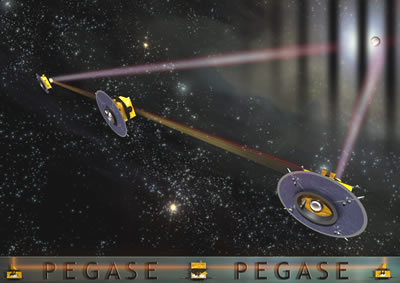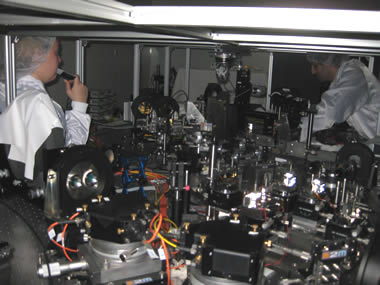ONERA’s cophasing system installed at the Meudon observatory validates future spectral analyses designed to reveal conditions suitable for life in the universe. Its performance is currently the best in the world and consolidates ONERA’s leadership in high angular resolution instrumentation.

Artistic view of the Pégase nulling interferometer: the planet on a bright fringe is isolated from the nearby star masked by a dark fringe (whose luminous halo can be seen). Credit: CNES.
 The search for planets beyond the solar system is a very active branch of astronomy. Since 1995, hundreds of exoplanets have been discovered and atmospheric components have been identified by spectroscopy for some of these. However, the spectral analysis for earth-type exoplanets, with environments that could harbour life, is very complex because the weak flux emitted by the planet has to be isolated from the strong flux of its nearby host star.
The search for planets beyond the solar system is a very active branch of astronomy. Since 1995, hundreds of exoplanets have been discovered and atmospheric components have been identified by spectroscopy for some of these. However, the spectral analysis for earth-type exoplanets, with environments that could harbour life, is very complex because the weak flux emitted by the planet has to be isolated from the strong flux of its nearby host star.
One of the rare solutions that make this observation possible is nulling interferometry in space. The system is observed with two (or more) sub-pupils, recombined in such a way as to cancel out the light from the host star with destructive interference, but whose direction and separation adjustment causes constructive interference for the planet.
The difficulty lies in the star extinction ratio, which must reach 10-6 for telluric planets in the infrared. Obtaining such a ratio requires an almost perfect interferometer and nanometric control of the optical path difference* between the sub-pupils, separated by some tens of meters and carried by formation-flying satellites that is subject to several different types of perturbation (solar thrust, vibrations, thermal drift). These real-time operations are the subject of the cophasing system developed by ONERA.
The purpose of the Persée bench, in operation at the Meudon Observatory since the end of 2010, is to validate the feasibility of such space missions, showing on the ground a host star extinction ratio better than 10-4, stabilised at 10-5 in the presence of representative disturbances injected intentionally for this purpose.

The Persée bench, born from a partnership between the CNES, ONERA, The Space Astrophysics Institute (Institut d'Astrophysique Spatiale), Thales Alenia Space and the Paris and Côte d'Azur Observatories, financed by the CNES with the support of the Ile-de-France region. Here, the bench is in its phase of alignment by Julien Lozi and Emilie Lhomé of the LESIA
The results obtained in 2011 are well beyond expectations since, for a duration of 100s, an extinction ratio of 8.8 10-6 with a stability of 9 10-8 was obtained, establishing a new world record. A lengthy duration measurement gave an average extinction ratio of 10-5 with a stability of 8.10-7 for 7 hours.
These performances are made possible by a detailed definition of the bench and from a sub-nanometric control of the optical path difference (0.33 nm rms being possible). ONERA contributed greatly by taking charge of the system analysis, participating in the definition of the interferometer and the delivery of the system for the real-time control of disturbances.
Work carried out by Julien Lozi, currently working on a thesis co-financed by the CNES and ONERA. Director : Marc Ollivier [IAS], co-director : Frédéric Cassaing [Onera].
* In wave optics, the optical path difference (OPD) between two light rays from the same source is the difference between the optical paths travelled by these two rays. The interference of two light rays that coincide depends on the delay of one in relation to the other (see http://en.wikipedia.org/wiki/Optical_path_difference)




